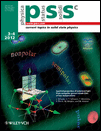Control of polarized emission from selectively etched GaN/AlN quantum dot ensembles on Si(111)
Abstract
Multiple layers of GaN/AlN quantum dot (QD) ensembles were grown by the Stranski-Krastanov method on Si(111) using molecular beam epitaxy. During the subsequent cooling from growth temperature, the thermal expansion coefficient mismatch between the Si substrate and GaN/AlN film containing the vertically stacked QDs leads to an additional biaxial tensile stress of 20–30 kbar in the III-nitride film. We have selectively modified the thermal stress in the QD layers by etching a cross-hatched pattern into the as-grown sample using inductively coupled Cl2/Ar plasma reactive ion etching. The results show that a suitable choice of stripe width from ∼2 to 10 μm and orientation along [11-20] and [1-100] can create regions of in-plane uniaxial stress that enable a selective and local control of the polarized luminescence from ensembles of QDs which were probed with cathodoluminescence. A theoretical modelling of the effects of carrier filling on the polarization anisotropy and the excitonic transition energy was performed, as based on three dimensional self-consistent solutions of the Schrödinger and Poisson equations using the 6 × 6 k·p method (© 2012 WILEY-VCH Verlag GmbH & Co. KGaA, Weinheim)




